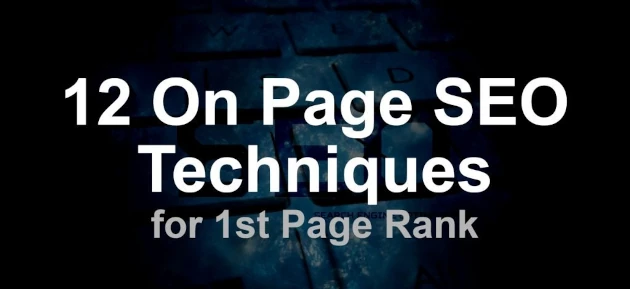Disclosure: Some links here are affiliate links. I get a commission if you buy, but you don’t pay extra. This supports my blog and lets me share quality content. I only suggest what I trust and use. Thanks!
Introduction
This post – 12 On Page SEO Techniques for 1st Page Rank – continues from the earlier post – What Is SEO and How Does It Work?
When you read the earlier posts mentioned above, you will understand that I am writing from this point of view – this series of posts are designed and written for those who would like to be digital marketers, learn more about digital marketing, or entrepreneurs who wish to learn about digital marketing for their online businesses.
Ready? Let’s start with the basic – What is On Page SEO?
Digital Marketing
Would you like to learn how to start and grow an affiliate marketing business? Join my I Love Passive Income community for more tips and useful business information. Simply fill in the details below, and you will receive an email with instructions on how to join this invaluable community.
What is On Page SEO?
On Page SEO is Search Engine Optimization techniques done on your website. It includes tactics such as strategically placing keywords on the pages of your website. For example, on the site title, page title, within the content, image alternate text tag, etc.
There are, of course, more techniques than just the ones mentioned. Here, I present 12 Effective On Page Seo Techniques that can get your website, page or post on 1st page of Google and other search engines. They are described in the following.
The Importance of Keywords
Keywords are critical to the success of your website and advertising campaigns. They are the words that people use to find products, services, brands and information. In short, they are the words people use to find your business, your website.

As a digital marketer, you will need to understand how important keywords are, and the significance of Keyword Research. To learn more about Keywords and Keyword Research, read this article about How To Find The Best Keywords For Your Website. It will help you with these 12 On Page SEO Techniques for 1st Page Rank.
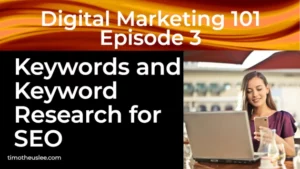
More about Keywords and Keyword Research, Click Image
Effective On Page SEO Technique #1 of 12 – Title Tag
The first of the On Page SEO technique I would like to share with you is the Title Tag. This is the title that you give for each page on your website. Take a look at the image below. The title tag is displayed in blue color on search engine results.
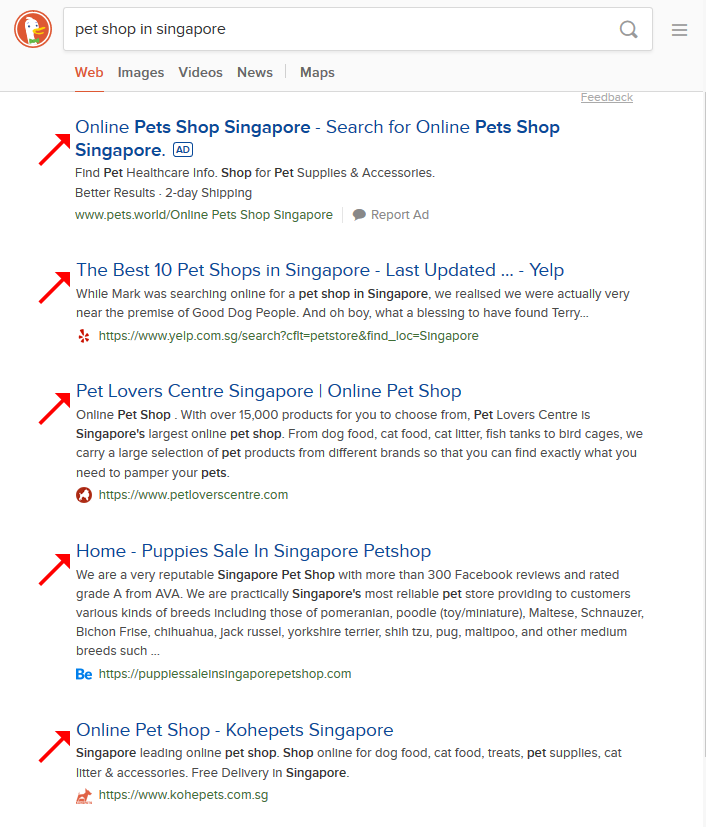
The title tag helps spiders or search bots to know what the main topic of a web page is all about. For example, from the image shown above, the title tag of Kohepets Singapore is – Online Pet Shop – Kohepets Singapore. This tells the search bots that the website is about online shopping for pet products by a brand named Kohepets Singapore.
One crucial point to note is that this is the text that most people will read on search engine results. Generally, it is the first thing searchers will see when they look at the list of search results.
Below are some tips for you. Take note on How to Write a Powerful and Effective Title Tag:
- Each page needs its own unique title tag. No duplicate titles on other pages.
- Ensure title is relevant to the content of the page
- Title Tag has a limit of 55 to 60 characters. Write wisely.
- Use local and national keywords
- Don’t use special characters like ($, %, @, etc)
- Don’t use call to action (call now, buy now, etc)
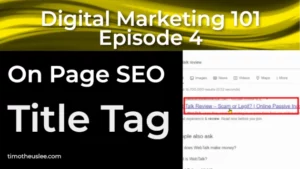
More about Title Tag, Click Image
Effective On Page SEO Technique #2 of 12 – Meta Description
The meta description provides a brief description of what the website or web page is all about. On search results, they appear just below the title tags. See the areas indicated by red arrows in the image below.

By the way, many experts have said that meta descriptions play little or no role in ranking your website higher. But I do find they do play some part in ranking.
I mean, take a look at the image above. Notice that the keywords are in bold? I believe that is a hint from the search engine that text in the meta description is considered. At least for relevance to the search query.
Nevertheless, meta descriptions are still important in the sense that searchers read them. They are opportunities for you to convince searchers to click on your link.
* Digital Marketing Tip: Meta Descriptions are excellent
to have Call to Action
If you do not add Meta Description to your website or web page, Google and other search engines will take random text from your website, and place it there. You may not like that to happen because you may end up with text that you do not want people to see.
Here are some tips on How to Write a Powerful and Effective Meta Description:
- Write compelling copy to increase number of people click through to your website
- Meta Description can have less than 160 characters. Write wisely.
- Try your best to make the meta description consistent with the title tag
- As mentioned above, you can include Call to Action
- You can ask questions to entice searchers to click on the link to your website
- No duplicate meta descriptions
- Write naturally
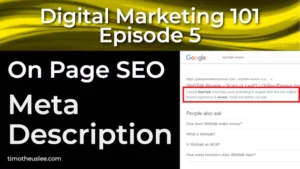
More about Meta Description, Click Image
Effective On Page SEO Technique #3 of 12 – Headings
Headings are great for breaking up the text and organizing your content into sections. This makes it easier for readers to consume the information. At the same time, it makes it easier for the search bots to understand what your website or web page is all about. Google and other search engines look at Headers to determine how relevant the page is to a user’s search query. As such, headers are one of the important On Page SEO factors that you must do.
As you write your content, organize it into sections. Then add headings for each section. The headers are usually a short summary or explanation of what the information within the section of content will be about.
Take a look at this article that you are reading. You will notice that for each of the On Page SEO Technique I am sharing, I have given a header before discussing about that sub topic. Another example is the header used in a travel blog (see image below):
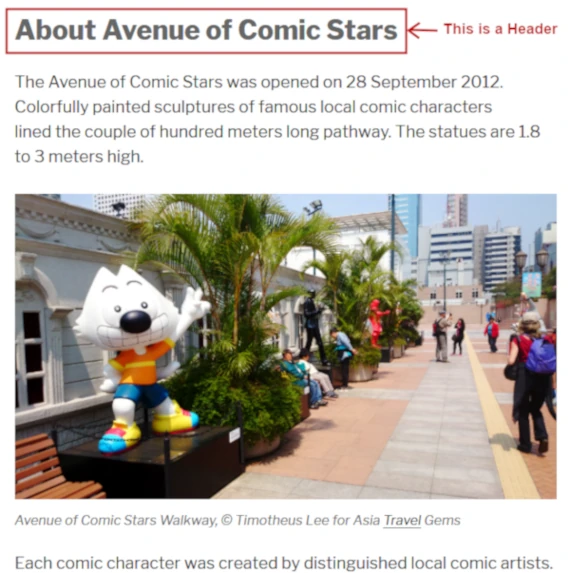
You can create up to 6 levels of headers. They are called H1 tag, H2 tag, H3 tag, H4 tag, H5 tag and H6 tag. The ‘H’ stands for Header, of course.
H1 is for the main heading of your web page or post. It can also be the title of your article. Add the keyword that you are ranking for into this main header.
H2 to H6 are the subsequent sub headers. They are sequential in levels. What this means is that H2 is the sub header within H1. H3 is the sub header within H2. And so on. Here is a look at how the levels are done:
- H1 tag for Header 1
- H2 tag for Header 2
- H3 tag for Header 3
- H4 tag for Header 4
- H5 tag for Header 5
- H6 tag for Header 6
- H5 tag for Header 5
- H4 tag for Header 4
- H3 tag for Header 3
- H2 tag for Header 2
* Digital Marketing Tip: Add Keyword to H1 only. For H2 to H6, write naturally. Make sure headers are relevant to section content
* Additional Digital Marketing Tip: Most sites use up to H4. Rarely H5 and H6 are used.
Here are some tips on How to Write a Powerful and Effective Headers:
- Use headings that are relevant to content, i.e. to each section
- Include your main keywords in H1s and H2s
- For H3 to H6, write naturally. Just make sure the headers is relevant to the section content
- Make sure the headings are related to the primary keyword/header for that page
- Don’t use special characters like $, %, @, etc
- Don’t use same headings each time
- Do not use one word headers
For the above point 6, where I said not to use the same headings, this is a rule that sometimes can be bent. It all depends on what you are writing, and how you are presenting the information. Also, when the repeated words make sense and easier for the readers to understand the content, then why not?
A good example is this very article that I am writing. I wrestled with whether to write the headers as the number of the On Page SEO – e.g. #3 of 7 – Headers. Then I felt that it would be too short, and will not make sense to the reader. Plus, it does not align with the primary keyword and header.
So, I decided to repeat the text – Effective On Page SEO Technique – followed by the numbering and the actual On Page SEO technique – i.e. Effective On Page SEO Technique #3 of 7 – Headers.
Today, when you do a search query, you will see images as part of the search results. Here is an example of how they will appear (see image below, red box):
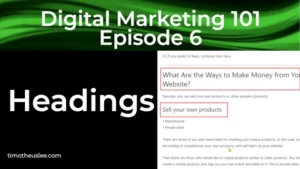
More about Headings, Click Image
Effective On Page SEO Technique #4 of 12 – Image Alt Text Tag
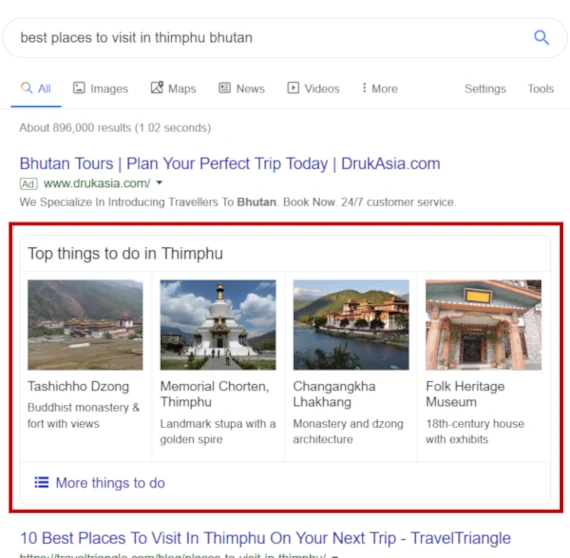
As you can see, the images appear high on a Search Engine Results Page (SERP). As mentioned in the article – What is SEO and How Does It Work?, 91.5% of searchers will click on a link that is on the 1st Page SERP. Thus, this increases traffic to your website. This makes images very important for SEO.
Another reason why images are becoming critical for SEO is that more and more people are using image search. They prefer images rather than text. In January 2019, Google reported that 19% of search queries are images. I just checked today, 26 June 2019, the image search queries have increased to 23%.
Google reports a daily search of 3.5 billion per day. 23% of that amount is around 805,000,000 searches per day! Can you, as a digital marketer, afford to lose that amount of potential traffic?
What is the Image Alt Text Tag?
The Alternative Text Tag is the text that can be seen when the image is not displayed. The tag also can be used by visually impaired users who are using screen readers. They can read the alt tag to better understand what the image is all about.
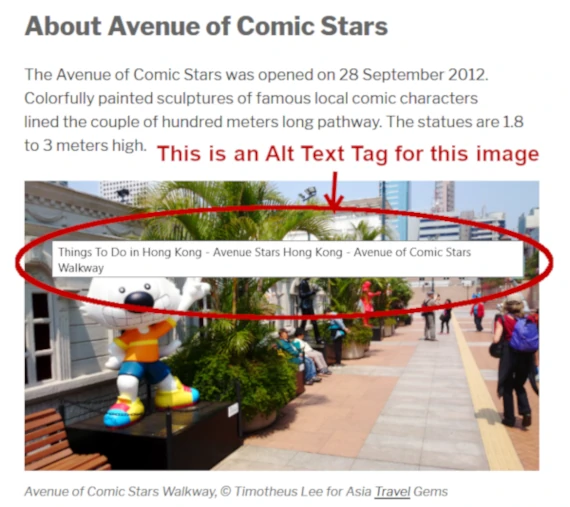
The most important part is for the search bots to understand what an image is about. You see, search bots cannot view an image. So, while you and can view an image, and we can interpret that image, search bots cannot do so. An Alt Tag informs the search bot all about an image, and enables them to be able to index that image.
When an image is indexed, it has the potential to appear on the image search results or even on the usual search results page, as seen above. Do you see the importance and potential of an image for SEO now?
Besides the usefulness for SEO, images can improve your content. A picture paint a thousand words. These days, people do not like to read blocks of text. Images can help break up the content, and make it more easy to consume.
With images, people will enjoy reading your articles. And will spend more time on your website. Again, this is good for SEO. When people stay for a longer time on your web page (rather than bounce off quickly), search engines translate that to your web page having quality and valuable content that people like. This boost the SEO ranking factor for your website, and as a result boosts your website’s ranking.
Here are some tips on How to Write a Powerful and Effective Alternative Text Tags:
- Make sure you own the images before you add to your website – e.g. photos taken by your using your camera or your mobile phone
- Buy stock photos if you cannot afford to take photos by a professional
- Alternatively, you can use images that are copyright free
- Use good quality photos
- Be aware of image size
- Use keywords in your filename
- Save images as GIF, JPG, PNG, WebP or SVG
- Add Alt Text Tags to your images
- Use your keywords in your Alt Text Tags – just one or two. This is not really necessary, too.
- Be descriptive – e.g. shoes vs red shoes with strap and 6 inch heels. The latter is better for SEO.
- Don’t need to use dashes
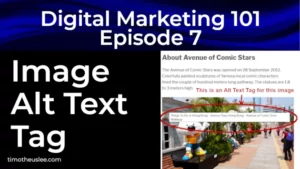
More about Image Alt Text Tag, Click Image
Effective On Page SEO Technique #5 of 12 – Online Videos
I have said it before. And I will continue to say it. Video is the future.
These days, as mentioned above, people prefer to see images. Better still, present the information in a video, and they will enjoy watching it.
In the past, there are those who argue that videos take too long to download. The playback is slow. And many other arguments. Today, videos can be downloaded or streamed very quickly. And with 5G on the horizon, there will be no issue about speed.
For SEO, it is ideal to create the videos on YouTube. Then embed that video into your blog post or web article. This will improve the ranking of your website or web page. It can even reach the coveted 1st Page position.
Below is a screen shot of a hotel review that included an embedded YouTube video. If you like to see how the video is added and complemented to the post, Click on the Image Below.
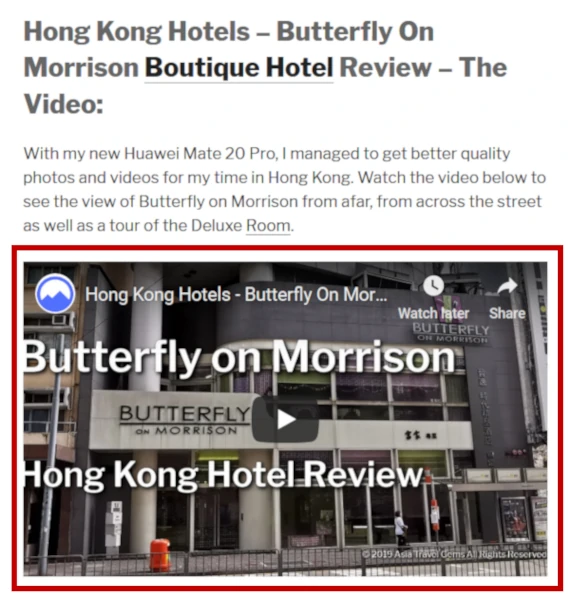
Consider this – YouTube is owned by Google. As such, it has been observed that embedding a YouTube video that is relevant to a blog post or article has helped increase ranking.
I know of an Internet Marketer who experimented with embedding videos. After his blog post reached the 2nd page of SERP, he created and embedded a YouTube video to that same post. The next day, his web page’s ranking reached the 1st Page.
But it is all not so simple as just creating and embedding a YouTube video. You need to do SEO for the video too. I will share more about this in a future post. Meantime, do join my mailing list to make sure you receive updates.
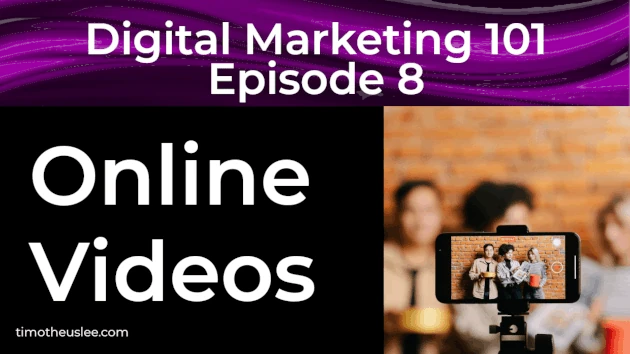
More about Online Videos, Click Image
Effective On Page SEO Technique #6 of 12 – Internal Linking
One of the powerful and effective On Page SEO technique is Internal Linking. This is achieved when you replace text on your posts with a link that directs visitors to a different page or post on your website.
Here is what it looks like. See the underlined text circled in red in the below image.
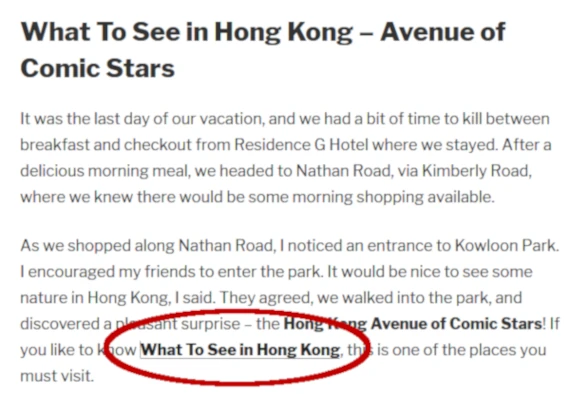
The words – What To See in Hong Kong – is linked to a page with that same title. It offers information about what sights to see in Hong Kong. So, when a reader is interested to find out more, they can click on the link and visit that page.
Internal links to a page are like votes. They tell search bots that the destination page has valuable and relevant information that readers will appreciate. This also makes it easier for the search engines to crawl your website as well as understand it.
Internal links also enhances user experience, and reduces bounce rates. By pointing to another page within your website that has more valuable and relevant information, you are helping your readers. It makes it easier for your visitors to explore your website. Also, as your readers continue to read more pages on your website, your bounce rates will be reduced.
Here are some tips on How to Do Powerful and Effective Internal Linking:
1. Use keywords to link
A lot of people write the words ‘Click here’, and then adds a link to these words. Just like now you have no idea what these words will take you to, it is the same for search engines. When search bots encounter these words, they too have no idea where the link for the words will go to.
It is better to write words that explain what the link will lead to. If it is about a specific topic, then write that specific topic. As shown in one of the images above, such an internal link is better. I attached that same image again for clarity.
As you can clearly see, the text tells a reader what topic the link will bring them to. So, when a reader is interested to find out more, they will click on that link.
2. Use links within paragraphs
In the same image above, you can see the hyperlink is done within a paragraph. This is ideal. It is natural. And I always advise people to write naturally.
Google and other search engines love it when we write naturally. As opposed to writing in such a way that is forced or just to please a search engine’s ranking algorithm.
3. Vary your keywords
There may be occasions when you would like to hyperlink to the same page more than once. This is not advisable. But I understand. I too have, at times, found opportunities to hyperlink to the same page on the same article.
When that happens, it is best to avoid using the same anchor text. This means using different words to link to that same page.
4. Don’t link to a page you are already on
This may sounds obvious but you will be surprised that many people do this.
Never link to the same article.
Remember – Internal Linking means linking to another page or post on your website.
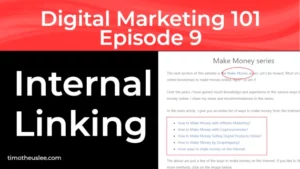
More about Internal Linking, Click Image
Effective On Page SEO Technique #7 of 12 – XML Sitemap
A sitemap is the architecture of an entire web site. It tells Google and other search engines what pages and posts are in a website and how they are categorized.
A sitemap is the architecture of an entire web site. It tells Google and other search engines what pages and posts are in a website and how they are categorized.
With a sitemap, you need to create the XML sitemap. This can be easily done by an SEO plugin such as All in One SEO or Yoast. These plugins will create your XML sitemap automatically. You can then use the XML sitemap link and submit to Google Search.
Submission of XML sitemap to Google Search informs Google that your site exists, and makes it easier for Google to index your website and pages. This will help in indexing for your website. And as a result, helps in ranking of your website and web pages. The submission of XML sitemap should also be done for other search engines such as Yahoo and Bing.
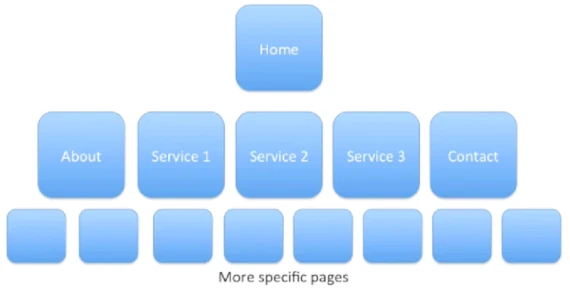
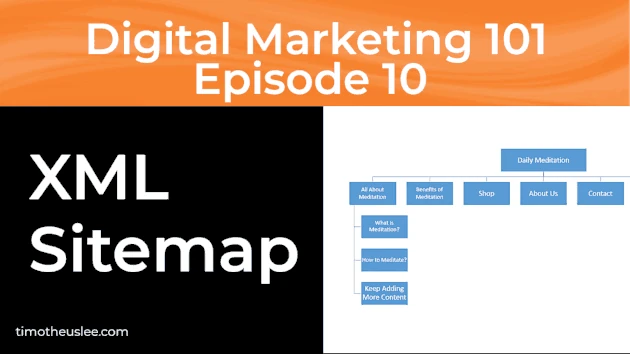
More about XML Sitemap, Click Image
Effective On Page SEO Technique #8 of 12 – No Duplicate Content
Here is something important that you, as a digital marketer, must know. Google and all search engines dislike duplicate content.
So, make sure that your website does not have any. If you need to create similar content on another page or website, use 301 redirect. Do not copy and the same content on that other page or website.
Also, use canonical tag. The canonical tag informs search bots which is the original content. Not sure how to do canonical tags? Speak to your webmaster about this.
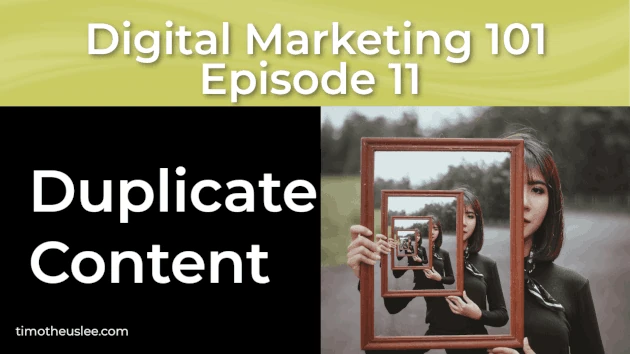
More about Duplicate Content, Click Image
Effective On Page SEO Technique #9 of 12 – No Broken Links
Have you ever surfed a website, and landed on a page with a message as shown below?
Frustrating, isn’t it? And it also contributes to bad user experience. So, no wonder search engines do not like them too.
So do yourself a favor. Check broken links on your website frequently. And if any are found, make sure you correct them.
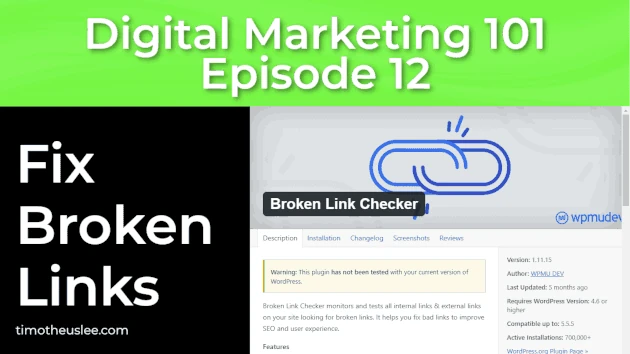
More about Broken Links, Click Image
Effective On Page SEO Technique #10 of 12 – SEO Friendly URL
Some websites have pages or posts where the URL is automatically generated. These usually create really bad URLs where it has no meaning for search bots. E.g. https://domain.com/cat/?cid=7078
It is better to create URLs that communicate better, that tells search bots what the web page is about. E.g. https://domain.com/whiskey/irish-whiskey/jameson
As you can see from above, the whiskey called Jameson is within the category of Irish Whiskey, which is within the main category of Whiskey. This is very good practice for URLs. It informs the search bots about the product name as well as what product category it is under.
Here are a couple of additional tips for SEO Friendly URL:
- Use your keywords in the URL
- Separate the words with dashes – e.g. you can see the above keyword – Irish Whiskey – is written as irish-whiskey
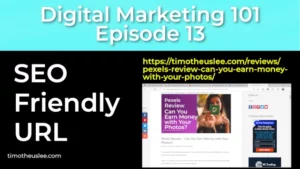
More about SEO Friendly URL, Click Image
Effective On Page SEO Technique #11 of 12 – Site Loading Speed
With 5G on the horizons, this may not be so much a concern. But for now, search engines like Google love fast loading websites. So, the speed that your site downloads to a browser, whether on desktop or mobile device, is a concern.
Before you decide to do anything about your website speed, test it out with one of Google’s site speed test tool – Page Speed Insights.
This Google tool is really useful. After it analyzes your website, it will provide you with suggestions on how to make your web page faster.
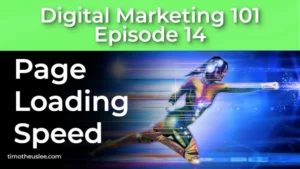
More about Site Loading Speed, Click Image
Effective On Page SEO Technique #12 of 12 – Mobile First – Mobile-Friendly Site
More and more people are using mobile devices. They use it to search for information, products, services and brands. They also use it to communicate with their network of friends and family as well as to socialize.
It is then no wonder that Google announced that they will be going Mobile First. And in 2019, this year, they will use the mobile version of content for indexing and ranking. Google has also hinted that non mobile friendly websites will be penalized; that is will be ranked lower.
It is very important for your website to be mobile-friendly. Sometimes this is also called a responsive website.
The first thing you need to do is to choose a theme that is responsive for your website. Or if it is hard coded, then make sure your programmers make your website mobile friendly.
Need to know if your website is mobile friendly? Google has a Mobile Friendly Test page.
Just like the above Page Speed Insights, this tool will analyze your website. And if there are any areas where your website is not mobile friendly, it will provide you suggestions on how to improve it.
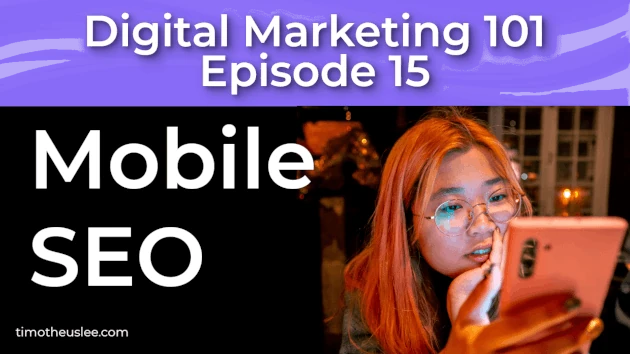
More about Mobile SEO, Click Image
Next, Off Page SEO
The above 12 On Page SEO Techniques for 1st Page Rank of your website is just the tip of the iceberg. There are many other factors to consider.
In my next article, I will share about Off Page SEO. With Off Page SEO and On Page SEO, you will have a very high chance of getting your websites on the 1st Page of Google and other search engines.
So, do join my mailing list to get updates when I publish new articles.

More about Off Page SEO, Click Image
Would you like to learn how to start and grow an affiliate marketing business? Join my I Love Passive Income community for more tips and useful business information. Simply fill in the details below, and you will receive an email with instructions on how to join this invaluable community.
12 On Page SEO Techniques for 1st Page Rank
Timotheus Final Thoughts
These 12 On Page SEO Techniques can help you get your web pages on the 1st pages of search results. I know from experience that they have for my web pages.
But it is not always a sure thing. It depends on your competitors. Sometimes, the competition is strong and it is hard to get on the 1st page.
Also, you need to put in time and effort to do Off Page SEO that can help your web pages get to the 1st Pages. It is a lot of work.
But definitely worth it, especially when you see your web pages on the 1st Pages and high volume of traffic is driven to your website.
Even more rewarding is when you get increase in sales and revenue.
Can’t Wait For The Next Blog Post?
Eager to find out more about digital marketing? And you would like the full and complete knowledge Now? Here is a link to the platform where I learned digital marketing, and stay updated on the latest trends.
The Bonus!
When you sign up, add a comment below to let me know. The bonus is that you get me as your mentor. Who am I? I have over 20 years of digital marketing experience, and I can help you succeed as a digital marketer or in your online business. If you would like to know more about me, go to this page About Me.
If you have ANY questions, or anything to clarify, please drop a comment below. I will be happy to help you.
I wish everyone great wealth and success.
Timotheus
Digital Marketer, Lecturer, Amazon Bestselling Author & Cancer Survivor
